Exploring the world of fresh herbs opens up a realm of different flavors and cooking possibilities. Parsley, a common herb known for its bright green color and earthy taste, is a staple in many kitchens. In this guide, we’ll delve into the 31 best substitutes for parsley. Each offers unique flavor profiles, ensuring that your dishes maintain their distinct tastes even when you’re out of this parsley.
This post may contain affiliate links.
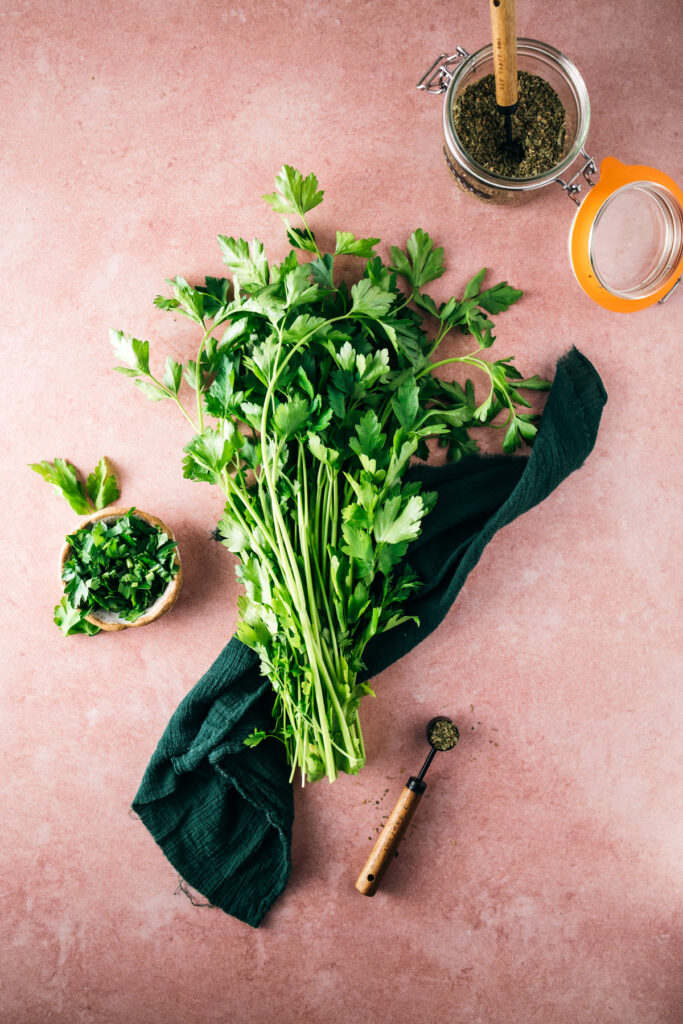
About Parsley
Parsley, a culinary cornerstone in kitchens around the globe, has a rich history and diverse usage. This common herb, renowned for its vibrant green leaves and refreshing flavor, originates from the central Mediterranean region, including southern Italy, Algeria, and Tunisia. It has been cultivated for more than 2,000 years and has become a staple in various cuisines worldwide.
There are two primary varieties of parsley, each with its unique characteristics and applications. Curly-leaf parsley, easily recognizable by its bright green, ruffled leaves, is often used as a garnish due to its decorative appearance. It has a milder taste compared to its counterpart, making it a versatile addition to a wide range of dishes. Curly-leaf parsley adds a fresh, crisp texture and subtle herby flavor to salads, soups, and sauces.
Flat-leaf parsley, also known as Italian parsley, boasts a more robust flavor and is a preferred choice in cooking over the curly variety. With its flat, pointed leaves, it’s commonly used in Italian dishes, imparting a slightly peppery and earthy flavor that complements a variety of ingredients. Italian parsley is fundamental to classic recipes like marinara sauce and gremolata. Beyond Italian cuisine, this type of parsley is widely used in Middle Eastern, European, and American cooking, often chopped and mixed into dishes like tabbouleh, chimichurri, and bouquet garni.
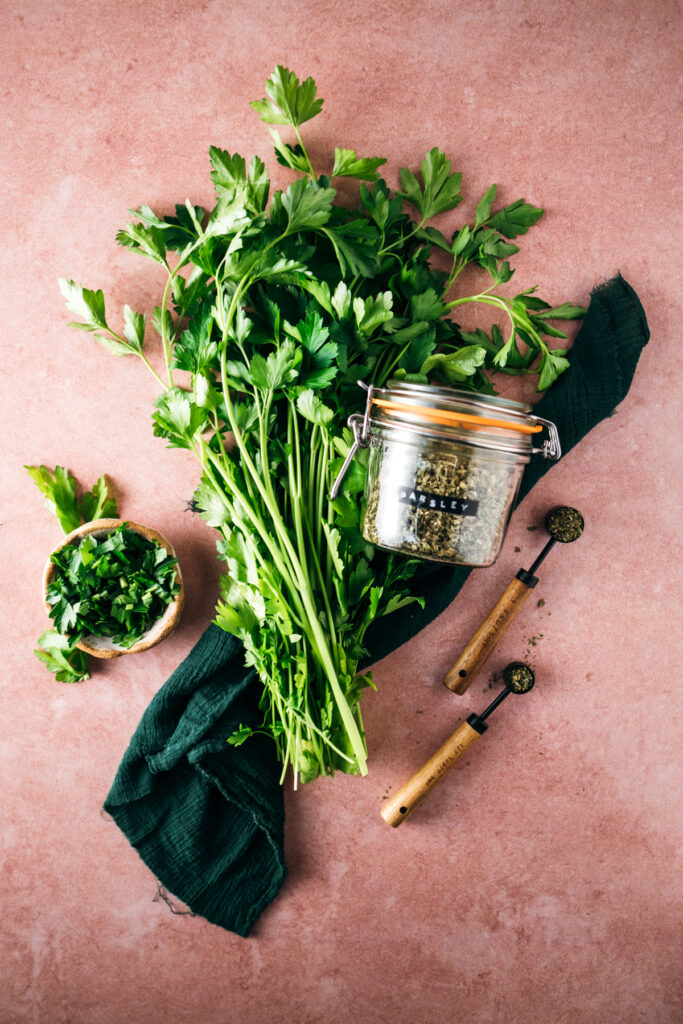
Fresh vs. Dried Parsley
While fresh parsley offers a bright and slightly bitter taste, dried parsley provides a more robust flavor. The choice between fresh and dried often depends on the recipe and personal preference. Fresh parsley is typically used for its texture and vibrant color, whereas dried parsley is convenient and has a longer shelf life.
Parsley Health Benefits
Parsley is not only flavorful but also packed with health benefits. It’s an excellent source of vitamin K. Consumption of foods rich in vitamin K has been shown to decrease symptoms of depression.
Parsley is also a good source of vitamins A, C, and folate. It is rich in antioxidants, flavonoids, and carotenoids. Antioxidants have been shown to protect your cells from free radicals and oxidative stress.
The List: 31 Best Parsley Substitutes
Embark on a flavorful journey and explore the best substitutes for parsley. From different parsley varieties to other fresh and dried herbs to rich leafy greens.
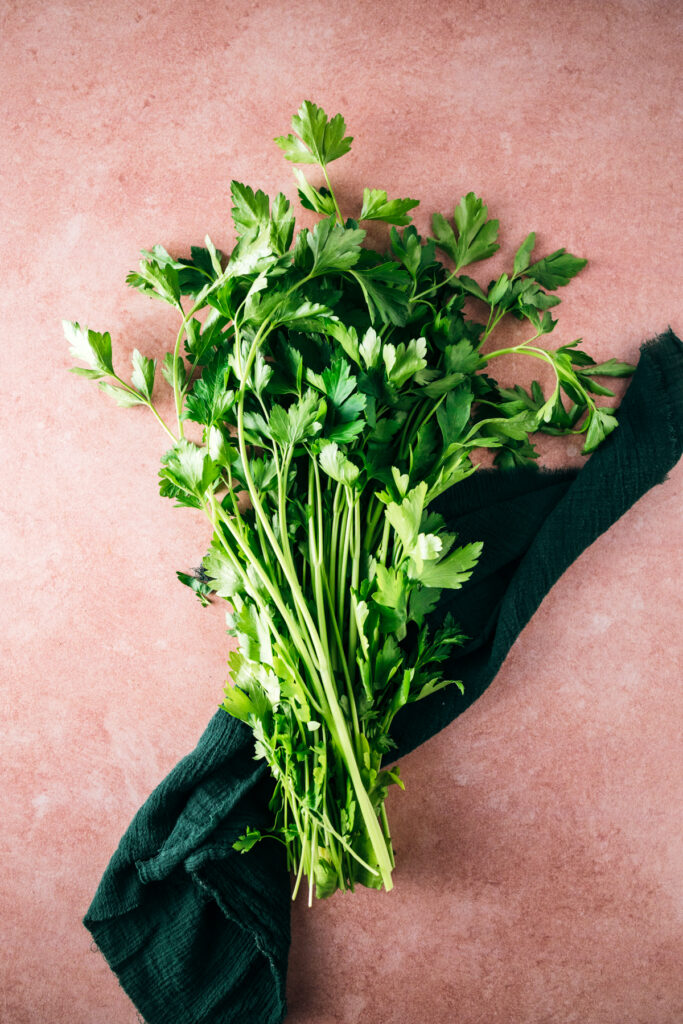
- Fresh Curly Leaf Parsley: This type of parsley has similar flavor profiles to other varieties of parsley. It is a great replacement in dishes where parsley is a star ingredient.
- Dried Curly Parsley: Dried curly parsley is an excellent substitute for dishes that require a true parsley flavor, especially for longer-cooked dishes.
- Fresh Italian Parsley: Known as flat-leaf parsley, this variety has a stronger flavor. This makes it a good fresh parsley substitute, especially in Italian dishes.
- Dried Italian Parsley: Dried Italian parsley is a great choice for dishes requiring a more robust herb presence.
- Hamburg Parsley: Also referred to as root parsley, this type of parsley offers a unique flavor. It is a good choice for soups and root vegetable dishes.
- Fines Herbes: This is an herb blend often used in French cooking. It usually includes minced parsley, tarragon, chives, and chervil leaves, offering a different flavor profile ideal for delicate sauces and dressings.
- Fresh Chervil: Offers a mild flavor with subtle hints of anise. It is a great parsley alternative in French cuisine, light salads, and as a garnish on your favorite dishes. It also looks very similar to Italian parsley.
- Dried Chervil: With its slightly sweet taste, dried chervil works well in soups and sauces, where it can contribute a light herbaceous flavor.
- Celery Leaves: Celery greens have a strong, slightly bitter taste. They make a great parsley alternative in soups, stews, and vegetable-heavy dishes, adding a robust depth of flavor.
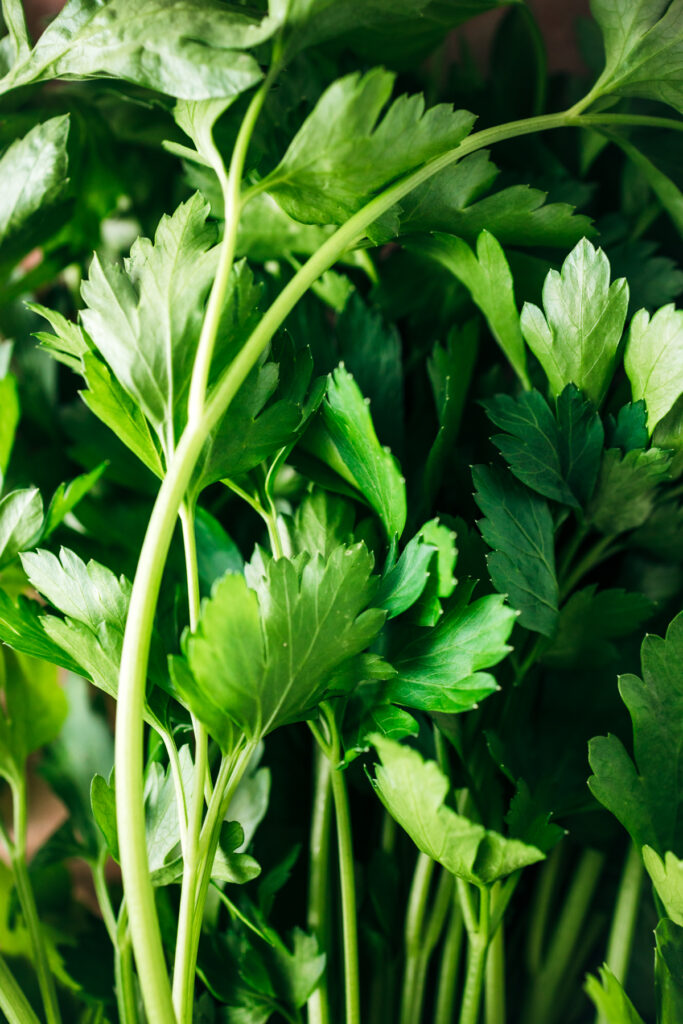
- Carrot Tops: With their earthy and slightly bitter flavor, carrot greens are a creative parsley substitute in homemade pestos, salads, and as a garnish, bringing a unique taste and reducing food waste.
- Arugula: With a peppery taste that’s slightly spicy, arugula works well as a parsley substitute. It’s tasty in salads, sandwiches, and as a pizza topping, where its bold flavor can shine.
- Dandelion Greens: These vibrant greens have a bitter and earthy taste. Use them as an alternative in salads and sautéed greens to balance rich, hearty dishes.
- Fresh Chives: Offering a mild onion-like flavor, fresh chives are excellent in dips, as a garnish, adding the perfect subtle, savory note.
- Dried Chives: Subtle and versatile, dried chives fit well in creamy sauces, soups, and potato dishes. They add a mild, onion-like flavor without overwhelming other ingredients.
- Green Onions: Their sharp and slightly sweet taste makes them an ideal parsley substitute in Asian cuisine and salads and as a garnish, offering both color and a gentle flavor enhancement.
- Fresh Cilantro (Coriander): With its bright, citrusy, and slightly peppery flavor, fresh cilantro is a great substitute for parsley. It’s ideal in Mexican, Asian, and Indian dishes, where its vibrant taste can stand out.
- Dried Coriander: Milder with a slightly citrusy, nutty flavor, dried coriander suits spice blends and curries, adding depth without overpowering other spices.
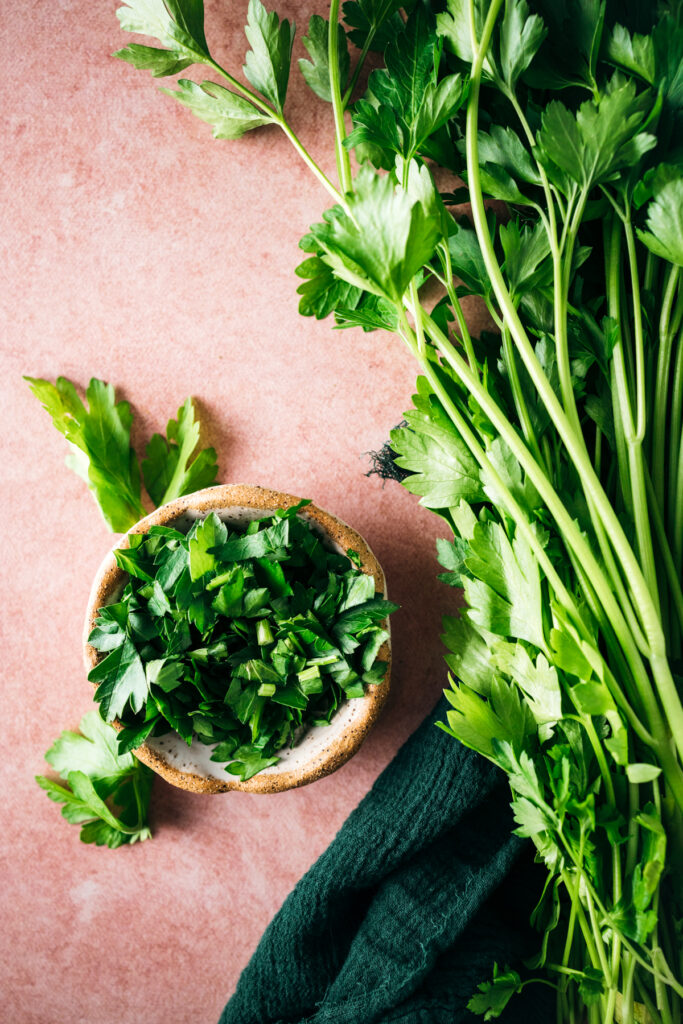
- Fresh Basil: Sweet and fragrant with a hint of pepper and mint, fresh basil is perfect for Italian cuisine, pesto, and fresh salads, offering a more aromatic alternative to parsley.
- Dried Basil: Concentrated and versatile, dried basil suits Italian sauces, dressings, and Mediterranean dishes, where its sweet and slightly spicy flavor can be a stand-out feature.
- Fresh Thai Basil: Known for its spicy, anise-like flavor, it is ideal in Thai and Vietnamese dishes. Here, its distinctive taste complements spicy and sweet flavors.
- Dried Thai Basil: Dried Thai basil retains a hint of its fresh counterpart’s unique spicy, anise-like flavor, making it suitable for Southeast Asian cooking, especially in stir-fries and curries.
- Fresh Oregano: Earthy, slightly bitter, and peppery, fresh oregano is ideal for Greek, Italian, and Mexican dishes. Its bold flavor complements tomatoes, salads, and pizza well.
- Dried Oregano: More intense than fresh, dried oregano is a staple in Mediterranean cuisine, especially in pizza, marinades, and grilled dishes, where its robust flavor can shine.
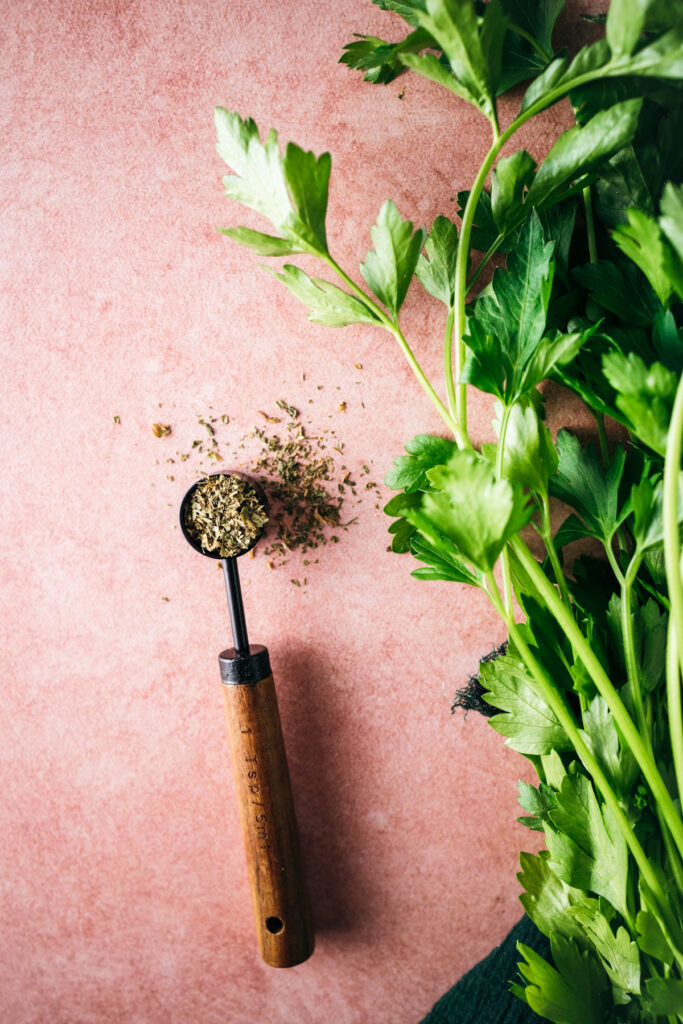
- Fresh Tarragon: Sweet with a hint of anise, fresh tarragon is excellent in French cuisine. Use it in salad dressings and creamy sauces, offering a sophisticated alternative to parsley.
- Dried Tarragon: Maintains a distinctive anise-like flavor, great for dressings, marinades, and French dishes, where its unique taste can add a gourmet touch.
- Fresh Mint: Cool and refreshing, with a strong flavor. Fresh mint adds a refreshing touch to salads, desserts, and beverages, offering a contrasting flavor profile to parsley.
- Dried Mint: More subtle in flavor, dried mint is used in Middle Eastern dishes like tabbouleh and cooling tzatziki, where it adds a gentle, refreshing note.
- Fresh Savory: Peppery and piney, fresh savory is perfect for hearty dishes, beans, and stews. Its robust flavor can stand up to strong ingredients.
- Dried Savory: More intense in flavor, dried savory is great for seasoning soups, and stews, offering a peppery, slightly bitter alternative to parsley.
- Endive: Slightly bitter and nutty, endive is an excellent addition to salads, gratins, and as a garnish, offering a crunchy texture and a flavor contrast to parsley.
- Watercress: Peppery and tangy, watercress is ideal in sandwiches, salads, and as a garnish. Its sharp flavor can add a fresh, spicy note.
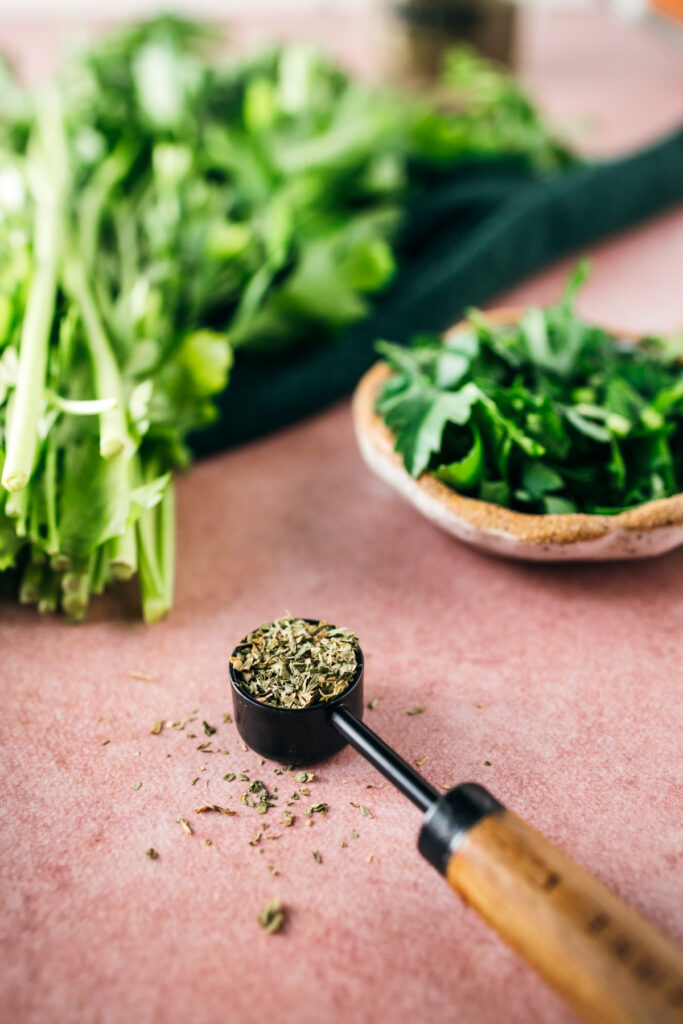
FAQ
Yes, parsley can be important for both flavor and presentation. However, many substitutes offer similar qualities.
Fresh mint is a great substitute, especially in salads, soups, and Middle Eastern dishes.
Absolutely, green onions can replace parsley for a milder flavor and a similar pop of color.
Dried chervil, dried oregano, or Italian seasoning can be excellent alternatives to dried parsley.
Final Words
In the world of culinary arts, parsley plays a significant role, but its absence doesn’t mean a compromise in flavor or health benefits. Some of these substitutes mimic parsley’s unique taste and offer their own range of nutrients, including those beneficial for mental health. Whether you’re experimenting with new flavors or simply out of parsley, these alternatives ensure your dishes remain vibrant and delicious.
Looking For More Substitutions?
Here are some more helpful ingredient substitutions for a flavorful plant-based journey!
- 25 Best Oregano Substitutions
- 17 Best Vegetable Bouillon Substitutes
- 31 Best Substitutes For Basil
- 20 Best Leek Substitutions
- 21 Best Substitutions For Turmeric
- 25 Best Dijon Mustard Substitutions
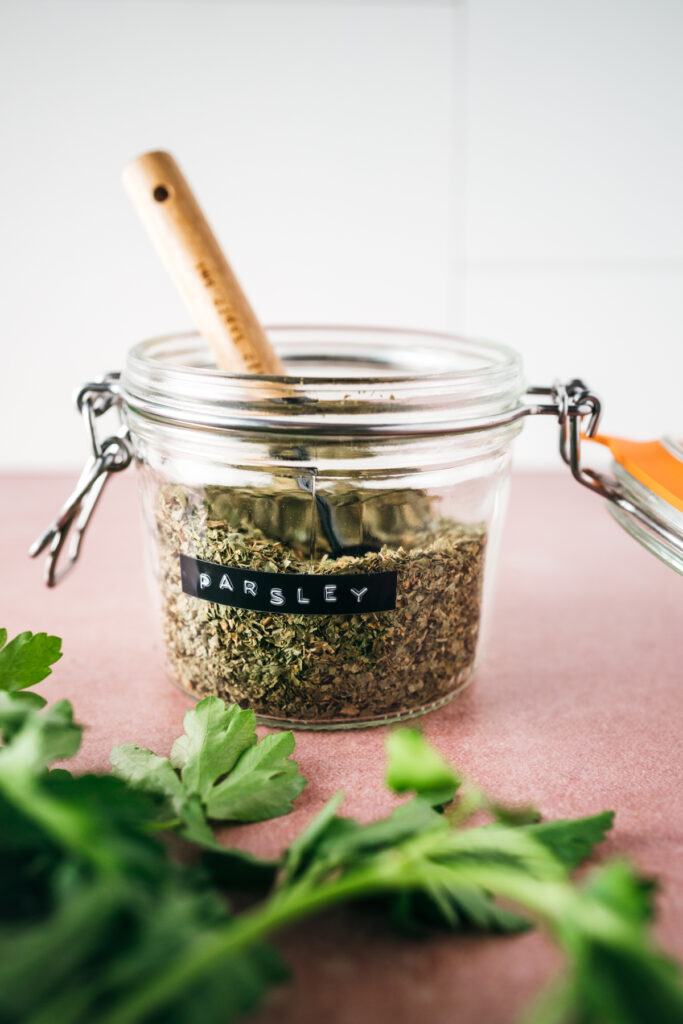
This post may contain affiliate links, meaning I’ll receive a commission if you purchase through those links at no extra cost to you. Please read our full disclosure for more information. Thank you for supporting Raepublic.
